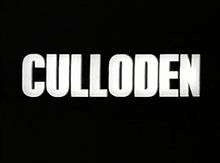Culloden (film)
| Culloden | |
|---|---|
 The title card | |
| Directed by | Peter Watkins |
| Written by | Peter Watkins |
| Cinematography | Dick Bush |
| Edited by | Michael Bradsell |
Release dates | 15 December 1964 (UK) |
Running time | 69 min. |
| Country | United Kingdom |
| Language | English, Scottish Gaelic |
Culloden is a 1964 docudrama written and directed by Peter Watkins for BBC TV. It portrays the 1746 Battle of Culloden that resulted in the British Army's destruction of the Scottish Jacobite rising of 1745 and, in the words of the narrator, "tore apart forever the clan system of the Scottish Highlands". Described in its opening credits as "an account of one of the most mishandled and brutal battles ever fought in Britain", Culloden was hailed as a breakthrough for its cinematography as well as its use of non-professional actors and its presentation of an historical event in the style of modern TV war reporting. The film was based on John Prebble's study of the battle.[1]
Production
Culloden was Watkins's first full-length film. It was also his first use of his docudrama style in which actors portray historical characters being interviewed by filmmakers on the scene as though it was happening in front of news cameras. The film was produced on a low budget, with only a handful of extras and a single cannon. Watkins made use of carefully planned camera angles to give the appearance of an army.[2]
Watkins also "wanted to break through the conventional use of professional actors in historical melodramas, with the comfortable avoidance of reality that these provide, and to use amateurs—ordinary people—in a reconstruction of their own history." He accordingly used an all-amateur cast from London and the Scottish Lowlands for the Hannoverian forces, and people from Inverness for the Jacobite army. This later became a central technique of Watkins's filmmaking.
According to an estimate by the cinematographer for the film, Dick Bush, about 85% of all camerawork in Culloden was hand-held.[3] This newsreel-style shooting gave an already gritty reality a sense of present action. Culloden looked like a documentary of an event which occurred before the camera was invented. From this the film illustrates the recognizable documentary style of cinéma vérité.[4]
Reception
Culloden won in 1965 both a Society of Film and Television Arts (BAFTA) TV Award for Specialised Programmes [5] and the British Screenwriters' Award of Merit. In a list of the 100 Greatest British Television Programmes drawn up by the British Film Institute in 2000, voted for by industry professionals, Culloden was placed 64th.[6] Writing for Eye for Film, Amber Wilkinson praised Culloden, commenting that "the mastery of [Watkins's] direction is obvious from first to last".[2]
Production crew
- Production design - Anne Davey, Colin MacLeod, Brendon Woods
- Makeup artist - Ann Brodie
- Sound department - John Gatland, Lou Hanks
- Production unit - Rodney Barnes, Valerie Booth, Roger Higham, Jennifer Howie, Michael Powell
- Historical advisor - John Prebble
- Production unit - Geraldine Proudfoot, Geoff Sanders
- Battle coordinator - Derek Ware
See also
References
- Notes
- ↑ "British Film Institute: Culloden". Retrieved 22 October 2011.
- 1 2 "Eye for Film: Culloden review". Retrieved 22 October 2011.
- ↑ Welsh, James Michael. Peter Watkins: a guide to references and sources. G. K. Hall & Co., Boston, 1986.
- ↑ Young, Colin. “Film and Social Change.” Journal of Aesthetic Education 3.3 (1969): 21-27.
- ↑ BAFTA TV awards for 1965
- ↑ "British Film Institute: 100 Greatest TV Shows". Retrieved 22 October 2011.
- Further reading
- Culloden, John Prebble, Atheneum 1962
- Peter Watkins' commentary on his first BBC documentary: www.mnsi.net/~pwatkins/culloden.htm
- Notes on 'Culloden' from Peter Watkin's website
- British Film Institute, Culloden, "Background and Context", www.bfi.org.uk/videocat/more/culloden/background.html
- Culloden entry in the BFI TV-100, 2000 list, www.bfi.org.uk/features/tv/100/list/prog.php3?id=64
External links
- Culloden at the Internet Movie Database
